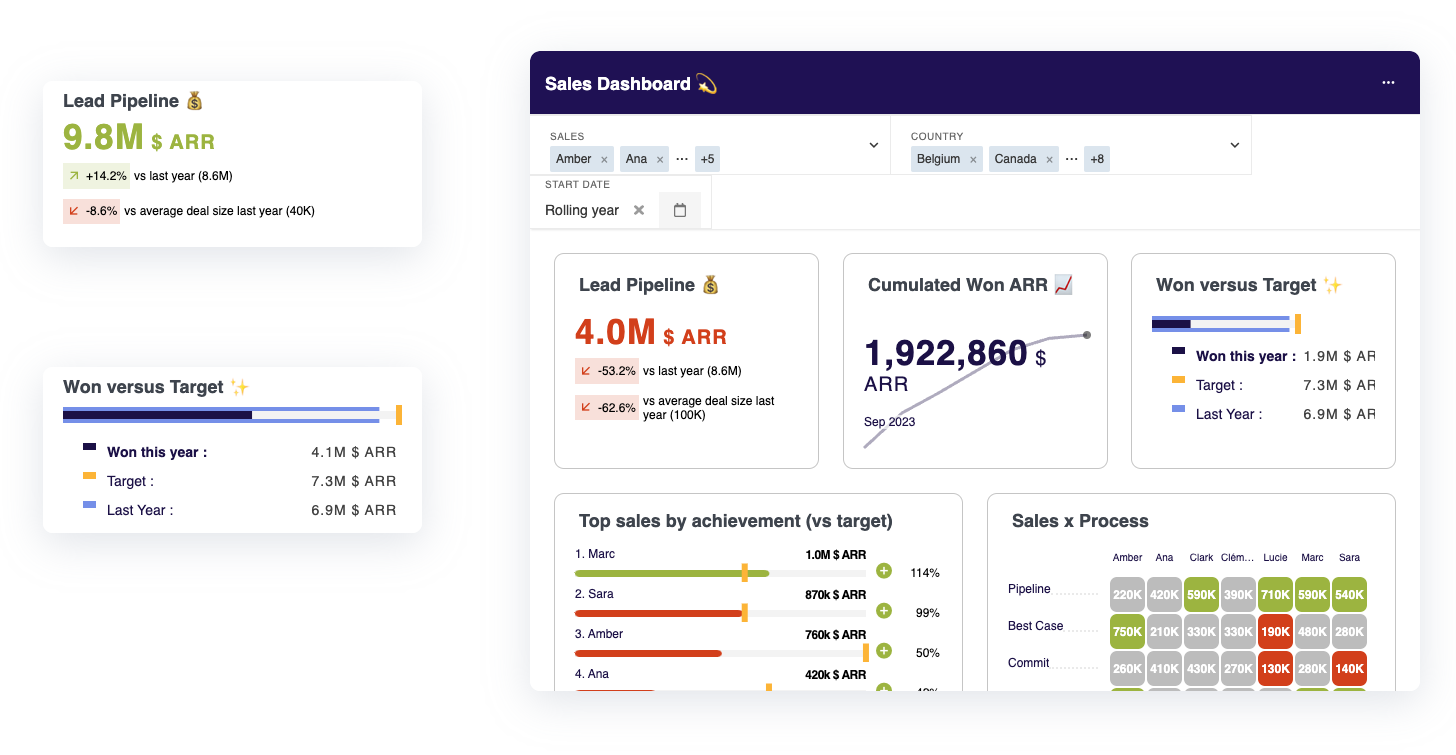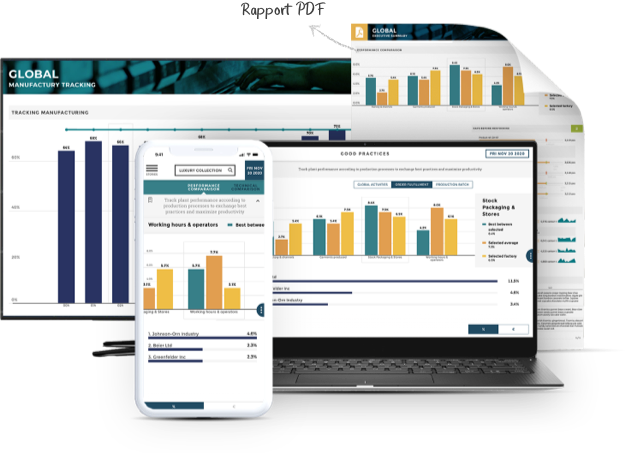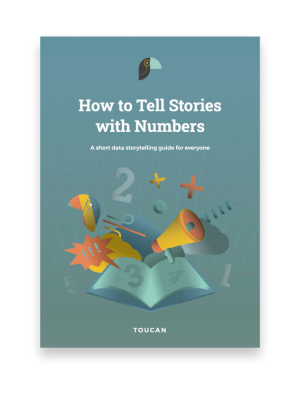
Using a database for analytics requires understanding analytical database software and its unique capabilities for storing business data collected from your company’s applications. A database for analytics is a scalable solution and data management system that allows you to store and organize key business metrics for business intelligence and analytics purposes.
These databases include frequently updated information and are typically a component of a broader data warehouse system. The best analytical database will provide an open-source solution, meaning that the codebase will be free to download, alter, and reuse without licensing and purchasing fees.
Open-source databases are essential solutions for scaling your business without paying high fees or struggling with licensing processes. Using an open-source analytical database means you can build new business applications using your existing technologies.
However, while an open-source database for analytics can transform your business, choosing the right analytical database can be challenging. Let’s explore what you should know about these databases and your options to find the right one for your business.
Types of Database Management Systems
Database Management Systems (DBMS) serve as crucial software systems designed for storing, retrieving, and executing queries on data. Acting as a bridge between end-users and databases, DBMS facilitate operations like data creation, reading, updating, and deletion within the database.
DBMS oversee the management of data, the database engine, and the database schema, empowering users and other programs to manipulate or extract data while ensuring data security, integrity, concurrency, and standardized administration procedures.
Employing a schema design technique known as normalization, DBMS optimize data organization by breaking down large tables into smaller ones to eliminate redundancy in attribute values. Compared to traditional file systems, DBMS offers numerous advantages including enhanced flexibility and a sophisticated backup system.
Classification of database management systems can be based on various criteria such as the data model, database distribution, or user numbers. The predominant types of DBMS software include relational, distributed, hierarchical, object-oriented, and network systems.
- Distributed Database Management System: A distributed DBMS comprises logically interconnected databases spread across a network, managed by a centralized database application. This type of DBMS ensures data synchronization at regular intervals and guarantees universal updating of any data changes in the database.
- Hierarchical Database Management System: Hierarchical databases arrange model data in a tree-like structure, with data storage organized either in a top-down or bottom-up format, depicted through parent-child relationships.
- Network Database Management System: The network database model caters to complex relationship needs by allowing each child to possess multiple parents. Entities are structured in a graph accessible through various paths.
- Relational Database Management System: Relational database management systems (RDBMS) stand out as the most prevalent data model due to their user-friendly interface. Relying on data normalization within table rows and columns, RDBMS offer scalability, flexibility, and efficient management of extensive information.
- Object-Oriented Database Management System: Object-oriented models store data in objects rather than conventional rows and columns, leveraging object-oriented programming (OOP) principles that enable objects to possess members such as fields, properties, and methods.
--
There are three primary technology options for database management systems used in business analytics: MySQL, NoSQL, and PostgreSQL. Several open-source databases are built on these technologies.
Let’s look closer at these unique systems.
MySQL
MySQL is a relational database management system (RDBMS) and structured query language (SQL) database. It follows a tabular data model, meaning it uses tables with rows and columns to represent data rather than a large data storeroom. MySQL is organized into physical data files.
MySQL is one of the most popular open-source database management systems, ranking only behind the Oracle Database. Because this system is open-source, anyone can download and modify MySQL software. The software uses the GNU General Public License (GPL) to determine how it can be utilized in different situations.
MySQL powers several applications, including Netflix, Facebook, Shopify, Uber, and more. It’s widely used for traditional relational database applications and suitable for structured data. This software is often used for transactional systems, content management systems, and other applications where data consistency and atomicity, consistency, isolation, and durability (ACID) compliance are essential.
NoSQL
Another technology is Not Only SQL (NoSQL), a non-relational database that follows a diverse data model, including types like document, key-value, graph, and column-friendly designs.
NoSQL databases are non-tabular, meaning they store data differently compared to MySQL. NoSQL is beneficial for teams seeking technology that offers flexible scalability. It enables the storing and querying of data and business metrics outside traditional database structures.
This database stores data within a single data structure, like a JSON document. This system copies and stores data across servers to ensure accessibility and data reliability. NoSQL systems are flexible and can manage various data types, making them useful for situations where your data is unstructured or semi-structured.
NoSQL databases are often used in applications requiring high scalability and speed, such as IoT technologies, social media, and real-time analytics. Databases like MongoDB are based on NoSQL.
PostgreSQL
Finally, PostgreSQL is an RDBMS and SQL database that follows a tabular data model. PostgreSQL is an open-source relational database supporting JSON (non-relational) and SQL (relational) querying.
This database is known for being flexible and reliable and differs from other databases like MySQL because it supports different data types. It has advanced features, extensibility, and support for complex data types.
These features make PostgreSQL an excellent choice for applications that require ACID compliance, data integrity, and complex querying, including financial systems, geographic information systems (GIS), and data warehousing. Data warehouses like Redshift are based on PostgreSQL.
Top 6 Databases for Analytics
Here are six of the top databases for analytics to consider as you make a decision most suitable for your business.
Amazon Redshift
Based on PostgreSQL, Amazon Redshift is a fully managed, petabyte-scale data warehouse in the cloud. This open-source platform allows you to access and assess crucial data without requiring the configurations of a provisioned data warehouse system.
Offered by Amazon Web Services (AWS), Amazon Redshift is designed for high-performance analytics and is capable of handling petabytes of data using columnar storage. This system is optimized for complex analytical queries.
This system automatically provisions resources and includes a scalable data warehouse capacity to deliver fast performance. Using Amazon Redshift, you won’t incur additional charges when your data warehouse is idle, so you’re only paying for what you use.
Amazon Redshift lets users query immediately using the Amazon Redshift query editor v2 or a traditional business intelligence (BI) tool. Redshift allows you to:
- Unify your data with zero-ETL
- Maximize your data’s value with analytics and machine learning (ML)
- Access your best-price performance
- Accelerate ML in SQL
- Unite your data with third-party datasets
- Enhance your financial and demand forecasting
- Innovate your system with secure data collaboration
Google BigQuery
This SQL database is a fully managed, serverless enterprise data warehouse that allows businesses to manage and analyze large volumes of data using features like ML, geospatial analysis, and business intelligence. Google BigQuery is highly scalable, cost-effective, and renowned for quickly processing large datasets.
Google BigQuery supports standard SQL queries and integrates seamlessly with other Google Cloud services. Its serverless architecture allows businesses to use SQL queries effortlessly to answer any questions your organization has about its data with zero infrastructure management.
Google BigQuery allows users to read data collected from external sources, and its scalability and distributed analysis engine allows you to query terabytes and petabytes in seconds to minutes with a built-in query engine. One of the main benefits of this system is that you get high performance without having to handle additional infrastructure or rebuild indexes.
Snowflake
Another option for your database management needs is Snowflake, a cloud-native data warehousing platform offering advanced flexibility and scalability for data analytics. Snowflake is a fully managed Software as a Service (SaaS) system that provides a single platform for your company’s data warehousing, engineering, science, lakes, and application development needs. This system also provides the ability to securely store and share real-time data.
Snowflake separates storage from compute resources, allowing teams to scale each element independently. Known for its ease of use and support for various data types, Snowflake includes unique features to handle your company’s ongoing database needs.
Among Snowflake’s many solutions are:
- Optimized storage that provides unsiloed access to data, including data outside of Snowflake
- Elastic multi-cluster computing, which delivers high performance for various users, data volumes, and workloads
- Cloud services
- Snowgrid, a feature allowing teams to globally connect to apps and data across regions and clouds
- Snowflake Horizon, a built-in governance system that manages data security across apps
- Snowpark, a feature allowing teams to develop pipelines, apps, AI/ML models, and more
- Snowflake Marketplace
- Snowflake Partner Network, allowing you to drive insights with partner services
Microsoft Azure Synapse Analytics
Formerly known as SQL Data Warehouse, Microsoft Azure Synapse Analytics is a cloud-based warehousing service that manages large volumes of data and complex analytics. Microsoft Azure Synapse Analytics is an enterprise analytics platform that accelerates time to insight across your data systems and warehouses.
This SQL system combines the best features of SQL technologies used for enterprise data warehousing, including Azure Data Explorer for log and time series analytics and Apache Spark technologies for big data analytics. Azure Synapse also includes pipelines for data integration and integration with other Azure services, such as Power BI, AzureML, and CosmosDB. The software supports on-demand and provisioned resources.
PostgreSQL
PostgreSQL is a reliable open-source relational database management system (RDBMS) known for its reliability, unique features, and high-performance capabilities. It includes advanced features and extensions, making it suitable for various data warehousing and analytical workloads despite being primarily a general-purpose RDBMS. Extensions like the TimescaleDB extension are compatible with PostgreSQL to provide time-series data analytics.
This object-relational database management system is a descendant of the original Berkeley code, providing modern features including:
- Complex queries
- Foreign keys
- Triggers
- Transactional integrity
- Updatable views
- Multi-version concurrency control
- Adding new features through extensions, including new data types, operators, functions, index methods, aggregate functions, and procedural languages
ClickHouse
Finally, ClickHouse is an open-source, columnar-oriented database system created to provide high-performance analytics. This highly scalable database management system is created for online analytical processing (OLAP) and is well-suited for companies seeking real-time analytical queries and managing large volumes of data.
If your business manages applications with large structured data sets, ClickHouse is one of your best options. The system can maintain a high performance for several reasons:
- Data compression
- Column-oriented storage
- Vector computation engine
- Physical sparse indices
- Approximated calculations
Analytics on Top of Your Database With Toucan
Making your data collected through a database for analytics actionable requires solutions like Toucan. Toucan helps make your data actionable with data storytelling and embedded analytics capabilities, ensuring you get the most from your company’s data management solutions.
Get a demo of Toucan today to see how our data storytelling capabilities can enhance your business!



.png)



